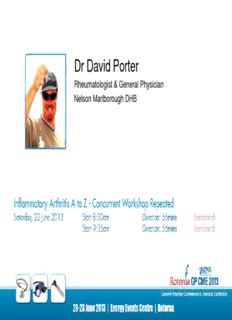
WS 192 Porter_Infla.. PDF
Preview WS 192 Porter_Infla..
Dr David Porter Rheumatologist & General Physician Nelson Marlborough DHB GENERAL PRACTICE SEMINAR - Rotorua David Porter June 2013 2 Perhaps the most critical issue in the initial assessment of a patient presenting with symptoms of arthritis is to determine whether or not the symptoms result from inflammation or not. This is because inflammatory problems usually ultimately stem from immune system activity, and require immunosuppressive treatment, an approach that is both ineffective, and potentially harmful, in non-inflammatory conditions. 3 June 2013 Usually, the distinction between inflammatory and non-inflammatory disease is easy. However, the distinction between inflammatory and non-inflammatory conditions can be one of the most difficult challenges in assessing patients with joint or musculoskeletal pain. Neither the degree of pain present, nor the degree and duration of morning stiffness have any utility in distinguishing inflammatory from non inflammatory disease. Patients with inflammatory sounding histories (ie pain with prominent morning and inactivity stiffness, or swelling) must have an ESR and CRP done and a physical examination. ESR and CRP usually correlate, but it is not uncommon for one to be markedly elevated whilst the other is normal or marginally raised. 4 June 2013 In the primary care setting, more patients presenting with pain and stiffness are going to have fibromyalgia than inflammatory arthritis. Fibromyalgia should be considered when a patient presents with what sounds a convincing history of inflammatory arthritis, but both the physical examination and laboratory data provide no objective evidence of inflammation. Fibromyalgia needs to be included in the differential diagnosis early (at the first visit), rather than after several rounds of visits and negative investigations. If both inflammatory markers are normal and there is no heat, soft tissue swelling or effusion in any joint on examination, then inflammatory arthritis is unlikely, and evidence that supports a diagnosis of fibromyalgia sought. 5 June 2013 Features supportive of fibromyalgia include: Abnormal pain response. Usually this can be abundantly demonstrated by applying reasonably firm pressure to one or two trigger points. It is not necessary to test 18 trigger points, as the diagnosis is usually well and truly made after pressing 2 or 3 trigger points. ▪ Usually testing for tenderness at the lateral epicondyle of the elbows, trochanteric regions, upper posterior buttock and anterior chest is sufficient. ▪ Fibromyalgic patients have (objectively measured in experiments) increased pain responses to relatively benign stimuli. Poor and/or unrefreshing sleep. Chronic fatigue. Widespread paraesthesiae. Cognitive impairment – “fibro fog.” Irritable bowel or bladder symptoms. Migraine or headaches. 6 June 2013 Septic arthritis Patients presenting with a single hot swollen joint may have septic arthritis (gout being the major differential) and should be referred to the Orthopaedic or Emergency Departments for initial workup and management. Vasculitis/SLE Patients with multi-organ disease (eg with prominent skin rash – especially petechial shin rash), respiratory (upper or lower respiratory tract) involvement, mononeuritis multiplex, or active urinary sediment), or in whom there is a strong clinical suspicion of vasculitis should be discussed urgently with the rheumatologist or physician on call. 7 June 2013 Once objective evidence of inflammation is found (elevated inflammatory markers and/or objectively inflamed joints), attention should turn to diagnosis and initial management. Patients with less than 6 weeks of symptom duration can reasonably be treated with a short course of prednisone (eg 20mg/15mg/10mg/5mg daily each for a few days then stop), assuming simple NSAIDs (where not contraindicated) and paracetamol have not sufficiently controlled symptoms. This enables “weeding out” of the group of patients in whom disease is a monophasic illness only. Patients who develop recurrent inflammation or who present with more than 6 weeks of inflammation should have diagnostic tests performed (ESR, CRP, Rheumatoid factor, anti-CCP antibodies, ANA, ENA, dsDNA, urinalysis, FBC, U+E, LFT. HLA B27, Urate, Hepatitis B and/or C serology and cryoglobulins may be appropriate in selected cases). 8 June 2013 If a patient has recurrent inflammation following an initial course of steroid or progressive/persistent symptoms of more than 6 weeks’ duration, then there is a good case for institution of disease modifying anti-rheumatic drugs (DMARDs). 9 June 2013 Major diagnostic considerations at this point include (but are not limited to): Rheumatoid Arthritis Psoriatic Arthritis Lupus/Connective tissue disease/ANA associated arthritis Spondyloarthropathy (includes ankylosing spondylitis, reactive arthritis, IBD-associated arthritis, Psoriatic spondyloarthropathy) Gout 10 June 2013
Description: